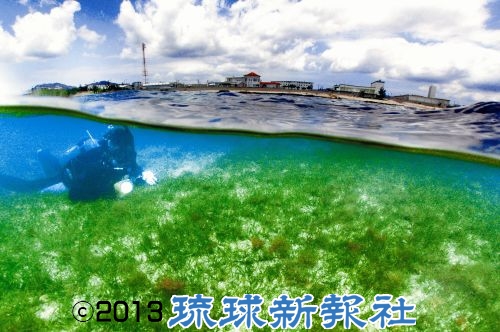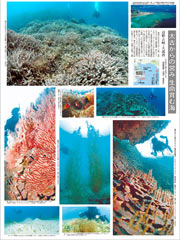Rich biogeocenosis located 100 meters offshore from Camp Schwab

On April 9, right under Camp Schwab’s nose, seaweed bed that feed dugongs extends underwater all around at a depth of one meter in Henokozaki district of Nago (Photograph taken by Futoshi Hanashiro and Takaya Kinra)
April 12, 2013 Ryukyu Shimpo
On April 8 and 9, staff of the Ryukyu Shimpo took underwater photographs in the area of Oura Bay where the U.S. military plans to construct the alternative facility for Futenma Air Station. The Oura River provides nutrients to help cultivate a rich biogeocenosis including naturally growing seagrasses that serve as food for dugong and massive Porites australiensis coral formations.
The Ryukyu Shimpo staff took photographs at several locations about 100 meters offshore from Camp Schwab, and 200 meters offshore from the Abu district of Nago, which is on the opposite side from where the alternative facility is scheduled to be constructed.

The staff confirmed the presence of seagrasses that feed dugong, Sargassum seaweeds that are akin to hijiki or Sargassum fusiforme seaweed, and akamoku or brown alga sargassum horneri.
They also found that young coral is growing offshore from Abu in the Porites australiensis formations.
Seishu Tanahara, who belongs to the Dugong Network Okinawa, and is knowledgeable about the living organisms of Oura Bay, said, “The forest provides nutrients to the bay, so this is where the forest, the river and the sea are linked. It is very likely that the construction of an alternative facility could change the tides and negatively impact on the natural environment.”
(English translation by T&CT, Mark Ealey)
Oura Bay off Henoko – a treasure trove of nature
April 12, Futoshi Hanashiro and Takaya Kinra of Ryukyu Shimpo
Massive coral formations extend in all directions under the water. Natural mozuku, a seaweed of the family Spermatochnaceae, grows in seaweed beds. Anemone fish sometimes poke their heads out from the sea anemone.
On April 8 and 9, staff members of the Ryukyu Shimpo went under the water around the Henokozaki district of Nago and Oura Bay, where the U.S. military plans to construct an alternative facility for Futenma Air Station.
Oura Bay is a deep estuary linked to land and to the Oura and Teima Rivers bringing nourishment from the hills and creating rich biodiversity.
The sea peacefully continues to nurture life despite the commotion surrounding the planned relocation to Henoko.
The Ryukyu Shimpo introduces the underwater photographs that its staff took of Oura Bay and Henoko.
(English translation by T&CT, Mark Ealey)
Slideshow of Rich biogeocenosis located 100 meters offshore from Camp Schwab

Previous Article:Okinawa Kenjinkai members enjoy annual events in Tucson, Arizona
Next Article:Gishi publishes Uchinaguchi version of Soseki’s I am a Cat
[Similar Articles]
- Fresh traces suggesting that dugong ate seaweed further out in Oura Bay
- Henoko seawall construction continues without transplanting Oura Bay coral
- Katsuren Peninsula: rich sea where coral reefs live
- In March, sounds appearing to be dugong calls recorded 23 times total, rare coral also found
- Oceanographer Muzik confirms the importance of Henoko Coast

 Webcam(Kokusai Street)
Webcam(Kokusai Street)


